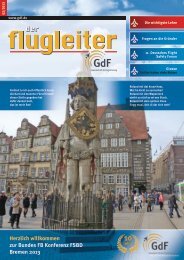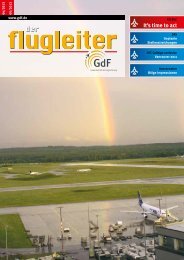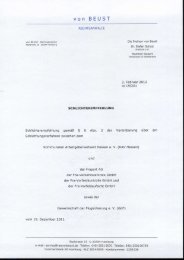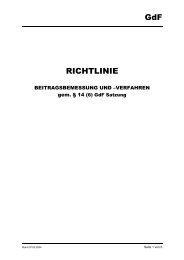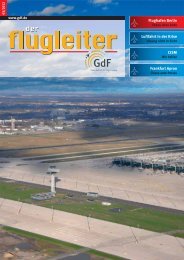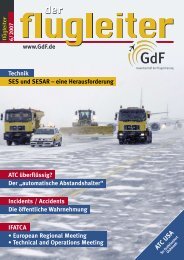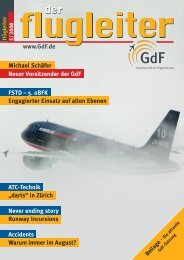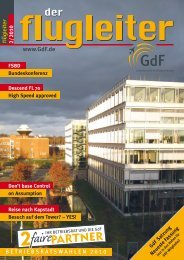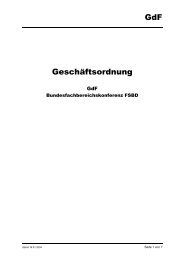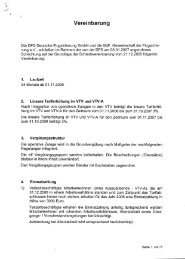5/2012 - GdF
5/2012 - GdF
5/2012 - GdF
Erfolgreiche ePaper selbst erstellen
Machen Sie aus Ihren PDF Publikationen ein blätterbares Flipbook mit unserer einzigartigen Google optimierten e-Paper Software.
IFALPA<br />
der flugleiter <strong>2012</strong>/05<br />
13ATSBL01<br />
Amendment 4 to ICAO PANS ATM (Doc 4444)<br />
The changes in PANS ATM complement those of Annex 6 Part I by providing the appropriate phraseology to be used in a Minimum or<br />
Emergency Fuel situation.<br />
Explanation<br />
These changes can basically be broken down into a 3 step approach whereby the flight crew notifies ATC of the progression of their fuel<br />
state when it has been determined by the crew that they are nearing a critical fuel situation. It is important to note that a common element<br />
in every scenario is that each time MINIMUM FUEL is declared, the PIC has already committed to land at a specific aerodrome and is<br />
concerned that a landing may occur with less than final reserve fuel in the tanks. It is equally important to note that, although the coordinated<br />
escalation process (with ATC) related to the protection of final reserve typically occurs in 3 steps, each situation is different, and<br />
may be resolved at any stage in the process. The 3 steps in the escalation process are:<br />
• Step 1<br />
Request delay information when<br />
required (in accordance with 4.3.7.2.1);<br />
• Step 2<br />
Declare MINIMUM FUEL when<br />
committed to land at a specific<br />
aerodrome and any change in the<br />
existing clearance may result in a<br />
landing with less than planned final<br />
reserve fuel (in accordance with<br />
4.3.7.2.2);<br />
• Step 3<br />
Declare a fuel emergency when the<br />
calculated fuel on landing at the nearest<br />
suitable aerodrome, where a safe<br />
landing can be made, will be less than<br />
the planned final reserve fuel (in<br />
accordance with 4.3.7.2.3).<br />
Seek information from ATC concerning any expected delays<br />
Declare “Minimum Fuel” which should represent the last lines<br />
of defense in a multilayered strategy designed to ensure the<br />
protection of final reserve fuel and safe flight completion.<br />
Practically speaking, the PIC should declare “MINIMUM<br />
FUEL” when, based on the current ATC clearance, the<br />
anticipated amount of fuel remaining upon landing at the<br />
aerodrome to which the aeroplane is committed is approaching<br />
the planned Final Reserve fuel quantity. This declaration is<br />
intended to convey to the applicable air traffic controller that so<br />
long as the current clearance is not modified, the flight should be<br />
able to proceed as cleared without compromising the PIC’s<br />
responsibility to protect final reserve fuel.<br />
Declare Fuel Emergency using “MAYDAY, MAYDAY,<br />
MAYDAY, FUEL”. The last in a series of procedural steps to<br />
ensure the safe completion of a flight is the declaration of an<br />
emergency. Conformance with Annex 6, Part I, 4.3.7.2.3 requires<br />
the PIC to declare a situation of emergency by broadcasting<br />
MAYDAY, MAYDAY, MAYDAY, FUEL when the calculated<br />
usable fuel to be available upon landing at the nearest suitable<br />
aerodrome where a safe landing can be made will be less than<br />
the planned final reserve fuel. This declaration provides the<br />
clearest and most urgent expression of an emergency situation<br />
brought about by insufficient usable fuel remaining to protect the<br />
planned final reserve. It communicates that immediate action<br />
must be taken by the PIC and the air traffic control authority to<br />
ensure that the aeroplane can land as soon as possible. The<br />
“MAYDAY” declaration is used when all opportunities to<br />
protect final reserve fuel have been exploited and in the<br />
judgment of the PIC, the flight will now land with less than final<br />
reserve fuel remaining in the tanks. The word FUEL is used as<br />
part of the declaration simply to convey the nature of the<br />
emergency to ATC. It is also important to note an emergency<br />
declaration not only opens all options for pilots (e.g. available<br />
closed runways, military fields, etc.) but it also allows ATC<br />
added flexibility in handling an aeroplane.<br />
©<strong>2012</strong> The International Federation of Air Line Pilots’ Associations<br />
IFALPA provides this data for information only, in all cases pilots should follow their company’s guidance and procedures. In the interests of flight safety, reproduction of this Bulletin in<br />
whole or in part is encouraged. It may not be offered for sale or used commercially.<br />
All reprints must credit IFALPA.<br />
23



